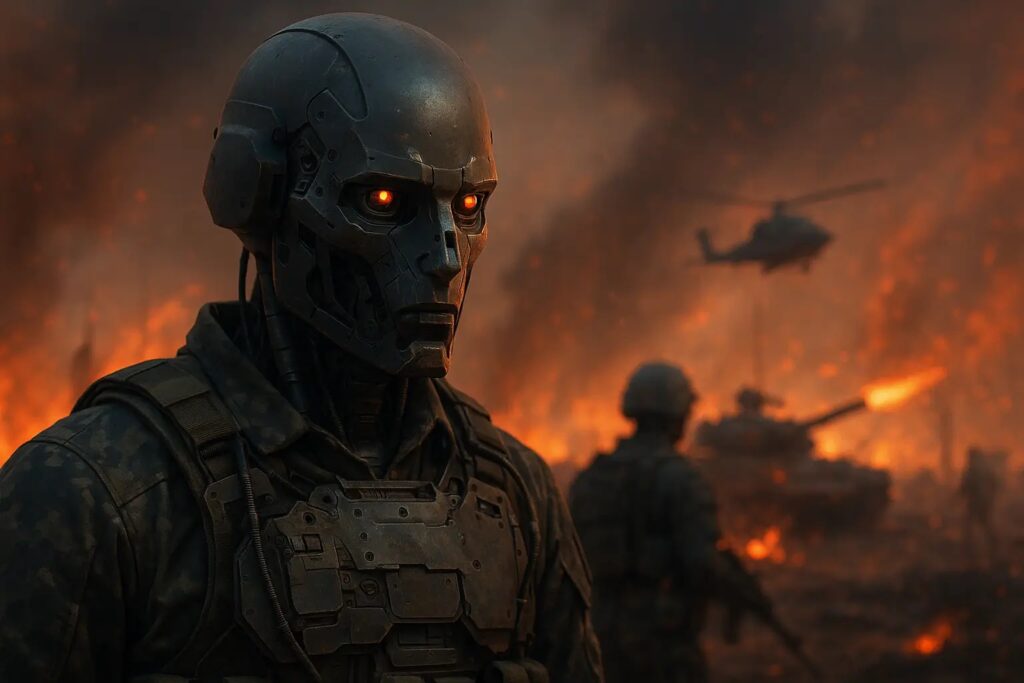AI in Warfare: The Future of War Has Arrived—And It’s Not Human
In today’s war zones, a silent revolution is unfolding. No longer confined to science fiction or military labs, artificial intelligence (AI) has stepped into real-world combat. From Ukraine’s frontlines to the South China Sea’s simmering tension, AI isn’t just supporting soldiers—it’s commanding strategy, targeting enemies, and making deadly decisions faster than any human ever could.
The era of machine generals is no longer coming. It’s already here.
The AI Arsenal: More Than Just Drones
When people think of AI in war, most imagine drones. But today’s AI-powered warfare goes far beyond unmanned flying machines. We’re talking about intelligent surveillance systems that can identify enemy movements in real time, battlefield robots that adapt to environments without human commands, and software that predicts enemy action before it happens.
In recent conflicts, AI systems have played critical roles—from guiding precision missile strikes in Gaza and Syria, to managing complex logistics networks in military operations across Europe. And that’s only scratching the surface.
Smart Targeting, Faster Than Thought
Modern AI can process battlefield data—satellite imagery, enemy troop patterns, supply movements—at a scale impossible for human commanders. It can flag targets, rank threats, and even suggest strike timings in a fraction of a second.
These systems are not guessing. They’re learning—constantly analyzing outcomes and improving their future performance.
The Cold Calculation of Code: No Room for Emotion
War, for centuries, has been defined by human emotion: fear, rage, compassion, vengeance. But AI knows none of these. It follows logic, algorithms, and probability. That’s both its strength—and its danger.
The Ethics of Autonomy
Imagine a drone that identifies and kills a target without human approval. It might sound like sci-fi, but it’s already happening. Several nations are developing—or have deployed—“killer robots” that operate with significant autonomy.
Critics argue that removing humans from the final decision to take a life erases moral accountability. Who’s responsible if the algorithm gets it wrong? Who pays when AI confuses a civilian for a combatant?
This ethical fog is one of the darkest clouds hanging over AI warfare.
AI on the Ground: Ukraine’s Silent Weapon
One of the clearest modern examples of AI in active combat comes from the ongoing war in Ukraine. Facing a larger and better-equipped Russian military, Ukraine turned to innovation. AI tools now help Ukraine identify missile trajectories, anticipate attacks, and manage drone strikes with pinpoint accuracy.
AI doesn’t sleep. It doesn’t panic. And in war, that calm, calculated thinking gives underdogs a fighting chance.
China and the U.S.: The Race for AI Dominance
Behind the battlefield, a larger war is being fought—in labs, data centers, and military think tanks. The U.S. and China are racing to lead the world in military AI, investing billions to stay ahead of one another.
H3: America’s AI War Doctrine
The Pentagon is investing heavily in AI integration, from predictive maintenance for tanks to semi-autonomous submarines that can patrol hostile waters. Their vision is clear: dominate with speed, precision, and fewer human casualties.
But the real prize is decision-making. Whoever controls the best AI will have battlefield awareness and predictive capabilities that leave the enemy blind.
China’s Smart War Strategy
China, meanwhile, has already woven AI into its military doctrine. Their AI monitors troop readiness, manages cyberdefense, and analyzes Western military strategies. Beijing’s strategy isn’t just to match the U.S.—it’s to leapfrog ahead using massive state-funded AI research.
Their focus? Total information control. Surveillance, cyberwarfare, and AI-powered drones all fall under this umbrella.
AI Doesn’t Just Fight It Spies
Beyond combat, AI is revolutionizing how wars are prepared. Facial recognition software now tracks enemy operatives globally. Deepfake detection is helping protect intelligence agencies. And AI bots sift through social media for signs of unrest, potential uprisings, or leaks in national security.
The Human Cost: Collateral Damage in the Age of Code
While AI makes war faster and seemingly cleaner, there’s a human toll we cannot ignore. Algorithms can make devastating mistakes. In 2020, a drone strike in Libya—guided by AI—killed individuals later confirmed to be civilians. No soldier pulled the trigger. A code did.
Who Holds AI Accountable?
There is no war crimes tribunal for software. And that’s the chilling part. As militaries become more reliant on AI, the line between lawful combat and unlawful killing gets blurred. Civilian oversight, transparency, and international law haven’t caught up with the speed of machine-led warfare.
Cyber Frontlines: Where AI Wages Invisible Wars
The battles we don’t see may be even more dangerous. AI is now the lead warrior in cyberwarfare launching, repelling, and defending against attacks that target financial systems, military databases, and critical infrastructure.
Hackers supported by AI can mimic human writing so well, they’ve fooled government officials. AI-generated phishing attacks are growing harder to detect. And if an AI manages to breach nuclear command systems? The consequences are unthinkable.
The World’s Ticking Clock: Regulate Before It’s Too Late
Governments across the globe are scrambling to catch up. The United Nations has warned about the dangers of unregulated lethal autonomous weapons. But diplomatic red tape is slow and machines move fast.
A Call for Global Standards
Experts argue that we need urgent global agreements AI “rules of war” before the next conflict escalates. That includes bans on fully autonomous lethal weapons, mandatory human oversight, and strong accountability mechanisms for AI-driven mistakes.
Final Thoughts: The Choice Between Control and Chaos
AI offers powerful tools that can reduce casualties, improve defense, and make militaries more efficient. But in the wrong hands—or left unchecked—it becomes a weapon of unimaginable destruction.
The truth is: AI doesn’t choose war. Humans do. But once unleashed, machines don’t feel guilt. They don’t question orders. And they never grieve the fallen.
In this new age of warfare, our greatest weapon may not be a missile or a drone—but wisdom. The wisdom to decide where to draw the line between progress and peril.

